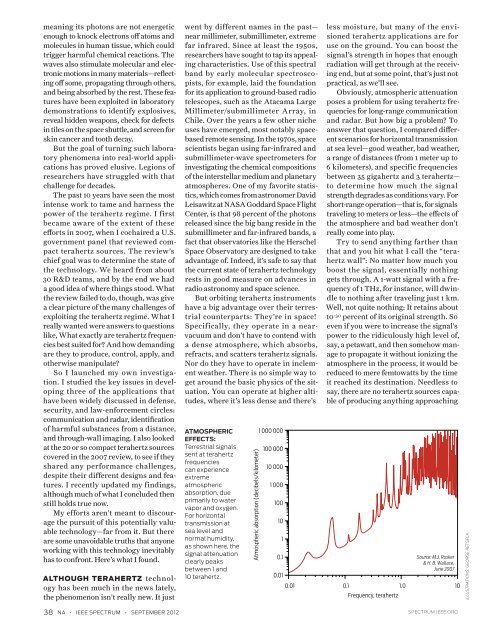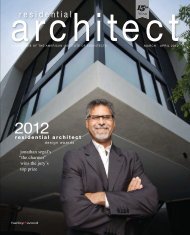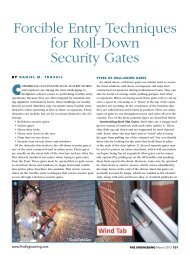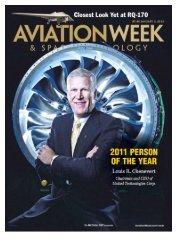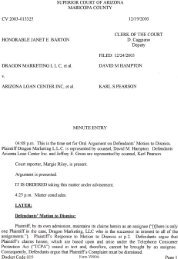The Truth About Terahertz
The Truth About Terahertz
The Truth About Terahertz
Create successful ePaper yourself
Turn your PDF publications into a flip-book with our unique Google optimized e-Paper software.
meaning its photons are not energeticenough to knock electrons off atoms andmolecules in human tissue, which couldtrigger harmful chemical reactions. <strong>The</strong>waves also stimulate molecular and electronicmotions in many materials—reflectingoff some, propagating through others,and being absorbed by the rest. <strong>The</strong>se featureshave been exploited in laboratorydemonstrations to identify explosives,reveal hidden weapons, check for defectsin tiles on the space shuttle, and screen forskin cancer and tooth decay.But the goal of turning such laboratoryphenomena into real-world applicationshas proved elusive. Legions ofresearchers have struggled with thatchallenge for decades.<strong>The</strong> past 10 years have seen the mostintense work to tame and harness thepower of the terahertz regime. I firstbecame aware of the extent of theseefforts in 2007, when I cochaired a U.S.government panel that reviewed compactterahertz sources. <strong>The</strong> review’schief goal was to determine the state ofthe technology. We heard from about30 R&D teams, and by the end we hada good idea of where things stood. Whatthe review failed to do, though, was givea clear picture of the many challenges ofexploiting the terahertz regime. What Ireally wanted were answers to questionslike, What exactly are terahertz frequenciesbest suited for? And how demandingare they to produce, control, apply, andotherwise manipulate?So I launched my own investigation.I studied the key issues in developingthree of the applications thathave been widely discussed in defense,security, and law-enforcement circles:communication and radar, identificationof harmful substances from a distance,and through-wall imaging. I also lookedat the 20 or so compact terahertz sourcescovered in the 2007 review, to see if theyshared any performance challenges,despite their different designs and features.I recently updated my findings,although much of what I concluded thenstill holds true now.My efforts aren’t meant to discouragethe pursuit of this potentially valuabletechnology—far from it. But thereare some unavoidable truths that anyoneworking with this technology inevitablyhas to confront. Here’s what I found.Although terahertz technologyhas been much in the news lately,the phenomenon isn’t really new. It justwent by different names in the past—near milli meter, submillimeter, extremefar infrared. Since at least the 1950s,researchers have sought to tap its appealingcharacteristics. Use of this spectralband by early molecular spectroscopists,for example, laid the foundationfor its application to ground-based radiotelescopes, such as the Atacama LargeMillimeter/ submillimeter Array, inChile. Over the years a few other nicheuses have emerged, most notably spacebasedremote sensing. In the 1970s, spacescientists began using far -infrared andsubmillimeter-wave spectrometers forinvestigating the chemical compositionsof the interstellar medium and planetaryatmospheres. One of my favorite statistics,which comes from astronomer DavidLeisawitz at NASA Goddard Space FlightCenter, is that 98 percent of the photonsreleased since the big bang reside in thesubmillimeter and far-infrared bands, afact that observatories like the HerschelSpace Observatory are designed to takeadvantage of. Indeed, it’s safe to say thatthe current state of terahertz technologyrests in good measure on advances inradio astronomy and space science.But orbiting terahertz instrumentshave a big advantage over their terrestrialcounterparts: <strong>The</strong>y’re in space!Specifically, they operate in a near -vacuum and don’t have to contend witha dense atmosphere, which absorbs,refracts, and scatters terahertz signals.Nor do they have to operate in inclementweather. <strong>The</strong>re is no simple way toget around the basic physics of the situation.You can operate at higher altitudes,where it’s less dense and there’sATMOSPHERICEFFECTS:Terrestrial signalssent at terahertzfrequenciescan experienceextremeatmosphericabsorption, dueprimarily to watervapor and oxygen.For horizontaltransmission atsea level andnormal humidity,as shown here, thesignal attenuationclearly peaksbetween 1 and10 terahertz.Atmospheric absorption (decibels/kilometer)1 000 000100 00010 0001 000100101less moisture, but many of the envisionedterahertz applications are foruse on the ground. You can boost thesignal’s strength in hopes that enoughradiation will get through at the receivingend, but at some point, that’s just notpractical, as we’ll see.Obviously, atmospheric attenuationposes a problem for using terahertz frequenciesfor long-range communicationand radar. But how big a problem? Toanswer that question, I compared differentscenarios for horizontal transmissionat sea level—good weather, bad weather,a range of distances (from 1 meter up to6 kilometers), and specific frequenciesbetween 35 gigahertz and 3 terahertz—to determine how much the signalstrength degrades as conditions vary. Forshort-range operation—that is, for signalstraveling 10 meters or less—the effects ofthe atmosphere and bad weather don’treally come into play.Try to send anything farther thanthat and you hit what I call the “terahertzwall”: No matter how much youboost the signal, essentially nothinggets through. A 1-watt signal with a frequencyof 1 THz, for instance, will dwindleto nothing after traveling just 1 km.Well, not quite nothing: It retains about10 -30 percent of its original strength. Soeven if you were to increase the signal’spower to the ridiculously high level of,say, a petawatt, and then somehow manageto propagate it without ionizing theatmosphere in the process, it would bereduced to mere femtowatts by the timeit reached its destination. Needless tosay, there are no terahertz sources capableof producing anything approaching0.1Source: M.J. Rosker& H. B. Wallace,June 20070.010.01 0.1 1.0 10Frequency, terahertzillustrations: George retseck38 NA • iEEE Spectrum • september 2012 spectrum.ieee.org


